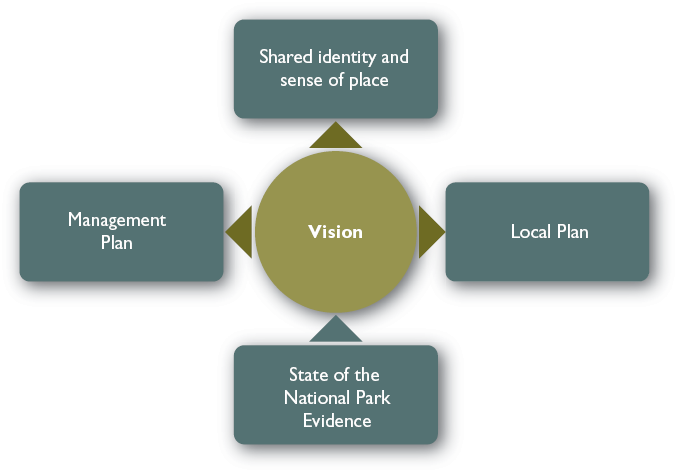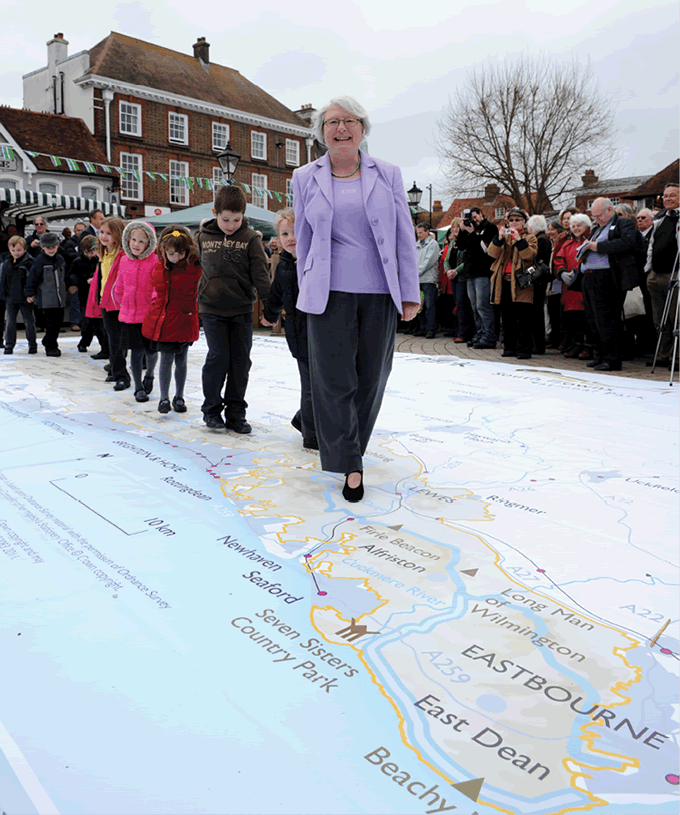Chapter 9
Looking ahead
This State of the South Downs National Park 2012 provides the foundation on which the National Park Vision, Management Plan, and the Local Plan will be built.
Measuring progress
This report provides a baseline for measuring change. Monitoring the key datasets featured throughout the chapters will provide a clear picture on the ways in which many aspects of the National Park are changing. New datasets are likely to emerge during the lifetime of this report, and, where relevant, these will be added as links to the online version.
In some places we have highlighted, using the help icon, gaps in key data which we believe need to be filled. We will work actively with other stakeholders, including the South Downs Partnership and the Learning Partnership (of colleges and universities) to fill these gaps.
Using the Management Plan and Local Plan to identify challenges and issues
This is the first complete picture of the South Downs National Park across its whole area and covering all of its special qualities. In developing the National Park Management Plan and Local Plan, the current state of the National Park will be considered alongside external factors, challenges and likely future trends, and the issues which will arise from these trends. These two plans will:
analyse these factors, challenges and trends;
identify and prioritise the most important issues; and
set out programmes and policies which will mitigate negative trends and allow positive opportunities to be grasped.
This report is not the place to pre-empt the issues which will feature in the Management Plan and Local Plan. There are, however, a number of broad challenges beginning to emerge which will need to be much more fully explored in these plans. A few examples help to illustrate how this will evolve:
Climate change impacts are already being felt in terms of growing seasons and weather patterns, leading to changes in the distribution and abundance of species, the quality of habitats, the availability of water, and the viability of different types of cropping and land use.
Improving the economic viability of the landscape – whether directly by producing food and timber, or indirectly by providing essential, natural services such as clean water – is the only genuine way of ensuring its long-term conservation and enhancement.
As part of the above, finding and promoting the most sustainable models for the future of farming, forestry and tourism will be extremely important.
The ecosystem services the National Park provides need to be better understood, quantified and valued: for example, in this heavily populated and dry part of Britain, better stewardship of water resources is likely to be a priority.
The population dynamics and trends in the National Park are complex and are likely to impact on its economy and communities in a very profound way in the future.
In their scale, character and dynamics, Petersfield and Lewes are significantly different to their surrounding rural areas. A distinct approach will be needed for each which identifies opportunities to link these towns more robustly with their hinterlands to achieve mutual benefit.
This list is merely indicative, there are many other issues which will need to be considered. The resolution of competing pressures and demands on each part of the National Park will be critical to it remaining an exceptional national asset. Given all of the above, the role of the Local Plan – its policies and, where appropriate, its spatial detail – will be crucial in ensuring that National Park purposes and duty can be secured together, rather than at the expense of each other.
The framework for creating an outward facing National Park
In an area with such a wealth of talent, resources and assets it is not appropriate for the National Park Authority to attempt to try and do everything itself – our role should be more that of an architect and catalyst than of a builder. The Management Plan provides a mechanism for many different partners and organisations to come together to deliver things by sharing ideas, knowledge and resources. Figure 9.1 sets out the relationship between this report, the Vision, Management Plan, Local Plan and work on an overarching brand and identity for the National Park.
Figure 9.1 A strategic framework for the National Park

The Vision sets out, succinctly, how the many stakeholders in the future of the National Park would like it to look and feel in 2050. With the Vision will come a basket of high level measures of the sorts of impacts on the ground these stakeholders would like to be able to measure: the Vision is where we want to be, these measures will tell us whether we are getting there.
The South Downs National Park Vision
|
By 2050 in the South Downs National Park: the iconic English lowland landscapes and heritage will have been conserved and greatly enhanced. These inspirational and distinctive places, where people live, work, farm and relax, are adapting well to the impacts of climate change and other pressures; people will understand, value, and look after the vital natural services that the National Park provides. Large areas of high-quality and well-managed habitat will form a network supporting wildlife throughout the landscape; opportunities will exist for everyone to discover, enjoy, understand and value the National Park and its special qualities. The relationship between people and landscape will enhance their lives and inspire them to become actively involved in caring for it and using its resources more responsibly; its special qualities will underpin the economic and social well-being of the communities in and around it, which will be more self-sustaining and empowered to shape their own future. Its villages and market towns will be thriving centres for residents, visitors and businesses and supporting the wider rural community; successful farming, forestry, tourism and other business activities within the National Park will actively contribute to, and derive economic benefit from, its unique identity and special qualities. |
The Management Plan will take the Vision and this State of the South Downs National Park 2012 as its starting point. It will set out in detail the challenges and identify the key issues they raise. Its focus will be firmly on the practical steps that can be taken towards achieving the Vision over the next five years, by setting out a number of overall priorities for joint action – each with a clear outcome which is supported by a delivery partnership of stakeholders who have committed resources to its achievement. Work is well underway to identify these priorities and partners.
The Local Plan will give a spatial and planning policy dimension to the Vision. It will set out overall planning policies which will apply across the National Park, and, where appropriate, include more detailed and localised spatial allocations for key uses such as housing, employment and leisure, together with other statutory elements such as the provision of gypsy and traveller sites. It will be complemented by a set of minerals and waste strategies developed in conjunction with the three County Councils and Brighton and Hove City Council, supported by neighbourhood plans developed by parishes and communities.
Finally, the work on shared identity and sense of place will use the Vision as the basis to work with many others to create a common look and feel for the National Park and a ‘sense of place’ toolkit which can be used by local communities and businesses, attractions, landowners, non-governmental organisations and utility companies.
|
The South Downs National Park is not a remote island of natural beauty, but a working landscape the future of which remains inextricably interdependent with the areas that adjoin it. The National Park is seen as a special place by its over 110,000 residents and also by citizens of surrounding cities and towns like Alton, Winchester, Eastbourne, Brighton and Hove, Portsmouth, Horsham and Crawley. These cities and towns make an enormous contribution to the National Park’s economy, providing visitors and commuters inwards to work, as well as purchasers of goods and services. Both its landscape and the interests of its people will therefore be best served by close working partnerships across its borders: the people, communities and businesses of the National Park and the areas around it are a great asset in achieving its purposes. However, their sheer numbers and pressure on resources also pose a great threat to its special qualities. The challenge, therefore, is to capitalise on the former and minimise the risk of the latter. A key challenge for both the Management Plan and Local Plan is therefore to bring together the interests of those inside and outside the National Park in a common endeavour. Taken as a whole, this suite of documents will provide a framework, rallying point and catalyst for the many organisations, communities and individuals who derive their livelihoods and their inspiration, from Britain’s newest and most populated National Park. |

SDNPA Chair Margaret Paren, launches the National Park in Petersfield © Glen Harris